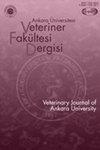Histochemical and Immunohistochemical Investigations on Pyloric Tonsil in Turkeys (Meleagris gallopavo)
IF 0.9
4区 农林科学
Q3 VETERINARY SCIENCES
引用次数: 0
Abstract
Structural patterns of pyloric tonsil in turkeys (Meleagris gallopavo) were investigated in this study. Turkeys, less resistant to disease than chickens, are a crucial source of protein with low cholesterol levels and a high protein/calorie ratio. Pyloric tonsil, involved in the chicken defense barrier, is a component of GALT. To evaluate the specific region, adult turkeys were taken from slaughterhouses. Crossman's modified triple staining demonstrated the general histological structure, PAS revealed the density of goblet cells synthesizing mucus, and Safranin O showed the capsule around the follicles. The width of lymphoid follicles in the pyloric tonsil (204.0±22.33) differed significantly from that of the middle part of the duodenum (111.7±4.741). It was noticed that the specific area harbors T cells, B cells, and follicular dendritic cells. Interfollicular regions were infiltrated with CD3+T cells, but the CD268+B cells occupied primarily germinal centers. However, it was noticed that T cells were present in germinal centers and some B cells in the interfollicular region. Anti-Vimentin antibody revealed follicular dendritic cells in the pyloric zone. It was noted that the epithelial layer of the pyloric tonsil is devoid of CK18-positive cells. Findings of the semi-thin section indicated that some columnar epithelial cells were stained differently in the transition zone (lymphoepithelium). To sum up, a pyloric region in turkeys is structurally dissimilar to pyloric tonsils detected in chicken, chukar partridge, and duck. More research is needed to reveal the effect of pyloric tonsil on the alimentary tract in poultry in terms of defense mechanisms.火鸡幽门扁桃体的组织化学和免疫组织化学研究
本研究对火鸡幽门扁桃体的结构模式进行了研究。火鸡对疾病的抵抗力不如鸡,是胆固醇水平低、蛋白质/热量比例高的蛋白质的重要来源。幽门扁桃体参与鸡的防御屏障,是GALT的一个组成部分。为了评估特定地区,从屠宰场采集成年火鸡。克罗斯曼改良三重染色显示了一般的组织学结构,PAS显示了合成粘液的杯状细胞的密度,番红O显示了卵泡周围的包膜。幽门扁桃体的淋巴滤泡宽度(204.0±22.33)与十二指肠中部的淋巴滤泡宽(111.7±4.741)有显著差异。CD3+T细胞浸润卵泡间区域,但CD268+B细胞主要占据生发中心。然而,我们注意到T细胞存在于生发中心,一些B细胞存在于滤泡间区域。抗波形蛋白抗体显示幽门区有滤泡树突状细胞。值得注意的是,幽门扁桃体的上皮层没有CK18阳性细胞。半薄切片的结果表明,一些柱状上皮细胞在过渡区(淋巴上皮)染色不同。总之,火鸡的幽门区域在结构上与鸡、丘卡鹧鸪和鸭的幽门扁桃体不同。需要更多的研究来揭示幽门扁桃体在防御机制方面对家禽消化道的影响。
本文章由计算机程序翻译,如有差异,请以英文原文为准。
求助全文
约1分钟内获得全文
求助全文
来源期刊
CiteScore
1.50
自引率
0.00%
发文量
44
审稿时长
6-12 weeks
期刊介绍:
Ankara Üniversitesi Veteriner Fakültesi Dergisi is one of the journals’ of Ankara University, which is the first well-established university in the Republic of Turkey. Research articles, short communications, case reports, letter to editor and invited review articles are published on all aspects of veterinary medicine and animal science. The journal is published on a quarterly since 1954 and indexing in Science Citation Index-Expanded (SCI-Exp) since April 2007.

 求助内容:
求助内容: 应助结果提醒方式:
应助结果提醒方式:


